Performance and Challenges of Service-Oriented Architecture for Wireless Sensor Networks
Abstract
:1. Introduction
2. Background and Concept
2.1. Middleware Architectures for WSNs
2.2. Service-Oriented Middleware (SOM) Architectures for WSNs
3. The Requirements of an SOA for WSNs
4. The Goals and Challenges of Middleware Architectures for WSNs
4.1. Scalability
4.2. Heterogeneity
4.3. Data Aggregation
4.4. Managing Limited Battery Power
4.5. Quality of Service (QoS)
4.6. Security
4.7. Fault Tolerance
5. The Taxonomy of Middleware Architectures for WSNs
5.1. Database Approach
5.2. Virtual Machine (VM) Approach
5.3. Message-Oriented Approach
5.4. Modular Approach
5.5. Application Driven Approach
5.6. Service-Oriented Architecture Approach
5.6.1. The Sensing Applications
5.6.2. The Tracking Applications
5.6.3. Context Awareness Applications
6. Service-Oriented Middleware (SOM) Architectures Approaches for WSNs
6.1. USEME
6.2. SOMDM
6.3. Mobile Web Services
6.4. MiSense
6.5. Sensors MiddleWare (SensorsMW)
6.6. OASiS
6.7. QoS for SOM Architecture
6.8. SOMM
6.9. TinySOA
6.10. ESOA
6.11. HealthCare Approaches
6.12. Other SOM Architectures for WSNs
7. Service-Oriented Architectures Approaches for WSNs
7.1. Network Discovery and Selection
7.2. Healthcare Approaches
7.3. Open Geospatial Consortium with Sensor Web Enablement (OGC SWE)
7.4. WSN Cloud User Interaction
7.5. Configuration Service
7.6. Service-Oriented Device Architecture for Smart Environments
7.7. SOA Model for Sensor Networks
7.8. Other Approaches
8. Service Composition for WSNs
8.1. Service Composition with Persistent Queries (SCPQ)
8.2. Service Centric Wireless Sensors Networks (SWSNs)
9. Analysis
9.1. The Service-Oriented Middleware (SOM) Architectures for WSNs
9.2. Service-Oriented Architectures for WSNs
9.3. Service Composition Architectures for WSNs
10. Discussion
- Secure executions and communications.
- Deployment of service providers and advertisement.
- Service consumer support to help discover/determine and register these services.
- Support for QoS requirements.
- Support for massive data and high level of communication load efficiently.
- The ability to view the heterogeneities of the underlying WSNs, which are hidden by abstractions.
- The ability to interoperate with multi-devices and systems.
- Client application service transparency.
- The ability to auto-modify and auto-discover mechanisms.
- Configurable services.
11. Conclusions
12. Recommendations for Future Work
Acknowledgments
Author Contributions
Conflicts of Interest
References
- Bispo, K.; Rosa, N.; Cunha, P. Sitrus: Semantic infrastructure for wireless sensor networks. Sensors 2015, 15, 27436–27469. [Google Scholar] [CrossRef] [PubMed]
- Xu, G.; Shen, W.; Wang, X. Applications of wireless sensor networks in marine environment monitoring: A survey. Sensors 2014, 14, 16932–16954. [Google Scholar] [CrossRef] [PubMed]
- Hadim, S.; Mohamed, N. Middleware for wireless sensor networks: A survey. In Proceedings of the 1st International Conference on Communication System Software and Middleware, Delhi, India, 8–12 January 2006; pp. 1–7.
- Mohamed, N.; Al-Jaroodi, J. A survey on service-oriented middleware for wireless sensor networks. Service Oriented Comput. Appl. 2011, 5, 71–85. [Google Scholar] [CrossRef]
- Meshkova, E.; Riihijärvi, J.; Oldewurtel, F.; Jardak, C.; Mähönen, P. Service-Oriented Design Methodology for Wireless Sensor Networks: A View through Case Studies. In Proceedings of the 2008 IEEE International Conference on Sensor Networks, Ubiquitous, and Trustworthy Computing (SUTC 2008), Taichung, Taiwan, 11–13 June 2008; pp. 146–153.
- Sollacher, R.; Niedermeier, C.; Vicari, N.; Osipov, M. Towards a service oriented architecture for wireless sensor networks in industrial applications? Int. Fed. Autom. Control Proc. 2009, 42, 2107–2112. [Google Scholar] [CrossRef]
- Busemann, C.; Gazis, V.; Gold, R.; Kikiras, P.; Leonardi, A.; Mirkovic, J.; Walther, M.; Ziekow, H. Integrating sensor networks for energy monitoring with service-oriented architectures. Int. J. Distrib. Sens. Netw. 2013, 9. [Google Scholar] [CrossRef]
- Chehri, A.; Mouftah, H.T. Service-oriented architecture for smart building energy management. In Proceedings of the 2013 IEEE International Conference on Communications (ICC), Budapest, Hungary, 9–13 June 2013; pp. 4099–4103.
- Sleman, A.; Moeller, R. SOA distributed operating system for managing embedded devices in home and building automation. IEEE Trans. Consum. Electron. 2011, 57, 945–952. [Google Scholar] [CrossRef]
- Zabasta, A.; Kondratijevs, K.; Kunicina, N.; Ribickis, L. Wireless sensor networks and SOA development for optimal control of legacy power grid. In Proceedings of the 16th International Conference on Mechatronics and Mechatronika Brno, Venice, Italy, 19–20 June 2014; pp. 113–118.
- Manso, M.; Calero, J.M.A.; Barz, C.; Bloebaum, T.H.; Chan, K.; Jansen, N.; Johnsen, F.T.; Markarian, G.; Meiler, P.-P.; Owens, I.; et al. SOA and wireless mobile networks in the tactical domain: Results from experiments. In Proceedings of the 2015 IEEE Military Communications Conference (MILCOM 2015), Tampa, FL, USA, 26–28 October 2015; pp. 593–598.
- Herrera-Quintero, L.F.; Maciá-Pérez, F.; Marcos-Jorquera, D.; Gilart-Iglesias, V. Wireless sensor networks and service-oriented architecture, as suitable approaches to be applied into its. In Proceedings of the 6th Euro American Conference on Telematics and Information Systems (EATIS), Valencia, Spain, 23–25 May 2012; pp. 1–8.
- Wang, M.-M.; Cao, J.-N.; Li, J.; Dasi, S.K. Middleware for wireless sensor networks: A survey. J. Comput. Sci. Technol. 2008, 23, 305–326. [Google Scholar] [CrossRef]
- Abangar, H.; Barnaghi, P.; Moessner, K.; Nnaemego, A.; Balaskandan, K.; Tafazolli, R. A service oriented middleware architecture for wireless sensor networks. In Proceedings of the Future Network and Mobile Summit Conference, Florence, Italy, 16–18 June 2010.
- Duan, Q. Applying the service-oriented architecture for network discovery and selection in the next generation wireless mobile networks. In Proceedings of the International Conference on Network-Based Information Systems, Indianapolis, IN, USA, 19–21 August 2009; pp. 380–385.
- Mechitov, K.; Agha, G. Building portable middleware services for heterogeneous cyber-physical systems. In Proceedings of the 2012 Third International Workshop on Software Engineering for Sensor Network Applications (SESENA), Zurich, Switzerland, 2 June 2012; pp. 31–36.
- Mohamed, N.; Al-Jaroodi, J. Service-oriented middleware approaches for wireless sensor networks. In Proceedings of the 44th Hawaii International Conference on System Sciences, Kauai, HI, USA, 4–7 January 2011; pp. 1–9.
- Golatowski, F.; Blumenthal, J.; Handy, M.; Haase, M.; Burchardt, H.; Timmermann, D. Service-Oriented Software Architecture for Sensor Networks. Available online: https://www.researchgate.net/profile/Frank_Golatowski/publication/228695105_Service-oriented_software_architecture_for_sensor_networks/links/0046351a8ae5a75f8b000000.pdf (accessed on 7 March 2017).
- Blumenthal, J.; Handy, M.; Colatowski, F.; Haase, M.; Timmermann, D. Wireless sensor networks—New challenges in software engineering. In Proceedings of the 2003 IEEE Conference on Emerging Technologies and Factory Automation (ETFA), Lisbon, Portugal, 16–19 September 2003; pp. 551–556.
- Ibbotson, J.; Gibson, C.; Wright, J.; Waggett, P.; Zerfos, P.; Szymanski, B.; Thornley, D. Sensors as a service oriented architecture: Middleware for sensor networks. In Proceedings of the Sixth International Conference on Intelligent Environments (IE), Kuala Lumpur, Malaysia, 19–21 July 2010; pp. 209–214.
- Xia, F. Qos challenges and opportunities in wireless sensor/actuator networks. Sensors 2008, 8, 1099–1110. [Google Scholar] [CrossRef] [PubMed]
- Bhuyan, B.; Sarma, H.K.D.; Sarma, N. A survey on middleware for wireless sensor networks. J. Wirel. Netw. Commun. 2014, 4, 7–17. [Google Scholar]
- Hadim, S.; Mohamed, N. Middleware: Middleware challenges and approaches for wireless sensor networks. IEEE Distrib. Syst. Online 2006, 7, 1. [Google Scholar] [CrossRef]
- Messina, F.; Pappalardo, G.; Rosaci, D.; Santoro, C.; Sarné, G.M.L. A trust-aware, self-organizing system for large-scale federations of utility computing infrastructures. Future Gener. Comput. Syst. 2016, 56, 77–94. [Google Scholar] [CrossRef]
- Comi, A.; Fotia, L.; Messina, F.; Rosaci, D.; Sarné, G.M.L. A partnership-based approach to improve QoS on federated computing infrastructures. Inf. Sci. 2016, 367, 246–258. [Google Scholar] [CrossRef]
- Al-Jaroodi, J.; Al-Dhaheri, A. Security issues of service-oriented middleware. Int. J. Comput. Sci. Netw. Secur. 2011, 11, 153–160. [Google Scholar]
- Lopez-Ramos, M.; Leguay, J.; Conan, V. Designing a novel SOA architecture for security and surveillance WSNs with cots. In Proceedings of the IEEE International Conference on Mobile Adhoc and Sensor Systems (MASS), Pisa, Italy, 8–11 October 2007; pp. 1–6.
- Azarmi, M.; Bhargava, B.; Angin, P.; Ranchal, R.; Ahmed, N.; Sinclair, A.; Linderman, M.; Othmane, L.B. An end-to-end security auditing approach for service oriented architectures. In Proceedings of the IEEE 31st Symposium on Reliable Distributed Systems (SRDS), Irvine, CA, USA, 8–11 October 2012; pp. 279–284.
- Hammoudeh, M.; Mount, S.; Aldabbas, O.; Stanton, M. Clinic: A service oriented approach for fault tolerance in wireless sensor networks. In Proceedings of the Fourth International Conference on Sensor Technologies and Applications (SENSORCOMM), Venice, Italy, 18–25 July 2010; pp. 625–631.
- Hammoudeh, M.; Kurz, A.; Gaura, E. Mumhr: Multi-path, multi-hop hierarchical routing. In Proceedings of the International Conference on Sensor Technologies and Applications (SENSORCOMM 2007), Valencia, Spain, 14–20 October 2007; pp. 140–145.
- Sahni, Y.; Cao, J.; Liu, X. Midshm: A flexible middleware for SHM application based on service-oriented architecture. In Proceedings of the 2016 IEEE Symposium on Service-Oriented System Engineering (SOSE), Oxford, UK, 29 March–2 April 2016; pp. 126–135.
- Chien-Chung, S.; Srisathapornphat, C.; Jaikaeo, C. Sensor information networking architecture and applications. IEEE Pers. Commun. 2001, 8, 52–59. [Google Scholar] [CrossRef]
- Heinzelman, W.B.; Murphy, A.L.; Carvalho, H.S.; Perillo, M.A. Middleware to support sensor network applications. IEEE Netw. 2004, 18, 6–14. [Google Scholar] [CrossRef]
- Koutsoukos, X.; Kushwaha, M.; Amundson, I.; Neema, S.; Sztipanovits, J. Oasis: A service-oriented architecture for ambient-aware sensor networks. In Lecture Notes in Computer Science (LNCS); Kordon, F., Sokolsky, O., Eds.; Springer: Berlin/Heidelberg, Germany, 2008; pp. 125–149. [Google Scholar]
- Amundson, I.; Kushwaha, M.; Koutsoukos, X.; Neema, S.; Sztipanovits, J. Oasis: A Service-Oriented Middleware for Pervasive Ambient-Aware Sensor Networks; Technical Report ISIS-06-0706; Vanderbilt University: Nashville, TN, USA, 2006. [Google Scholar]
- Leguay, J.E.E.; LopezRamos, M.; Kathlyn, J.M.; Conan, V. An efficient service oriented architecture for heterogeneous and dynamic wireless sensor networks. In Proceedings of the 33rd IEEE Conference on Local Computer Networks (LCN), Montreal, QC, Canada, 14–17 October 2008; pp. 740–747.
- Corre, B.L.; Leguay, J.; Lopez-Ramos, M.; Gay, V.; Conan, V. Service oriented tasking system for WSN. In Proceedings of the Developments in E-systems Engineering, London, UK, 6–8 September 2010; pp. 64–69.
- Coronato, A. Uranus: A middleware architecture for dependable AAL and vital signs monitoring applications. Sensors 2012, 12, 3145–3161. [Google Scholar] [CrossRef] [PubMed]
- Bai, Y.; Ji, H.; Han, Q.; Huang, J.; Qian, D. Midcase: A service oriented middleware enabling context awareness for smart environment. In Proceedings of the 2007 International Conference on Multimedia and Ubiquitous Engineering (MUE’07), Seoul, Korea, 26–28 April 2007; pp. 946–951.
- Ananthi, M.; Sumalatha, M.R. Integrating WSN with web services for patient’s record management using rfid. In Proceedings of the 3rd IEEE International Advance Computing Conference (IACC), Ghaziabad, India, 22–23 February 2013; pp. 605–609.
- Khedo, K.K.; Subramanian, R. A service-oriented component-based middleware architecture for wireless sensor networks. Int. J. Comput. Sci. Netw. Secur. 2009, 9, 174–182. [Google Scholar]
- Malatras, A.; Asgari, A.; BaugÉ, T. Web enabled wireless sensor networks for facilities management. IEEE Syst. J. 2008, 2, 500–512. [Google Scholar] [CrossRef]
- Sleman, A.; Moeller, R. Micro SOA model for managing and integrating wireless sensor network into IP-based networks. In Proceedings of the 2nd International Conference on Computational Intelligence, Communication Systems and Networks (CICSyN), Liverpool, UK, 28–30 July 2010; pp. 137–142.
- Kerasiotis, F.; Koulamas, C.; Papadopoulos, G. Developing wireless sensor network applications based on a function block programming abstraction. In Proceedings of the IEEE International Conference on Industrial Technology (ICIT), Athens, Greece, 19–21 March 2012; pp. 372–377.
- Cañete, E.; Chen, J.; Díaz, M.; Llopis, L.; Rubio, B. Useme: A service-oriented framework for wireless sensor and actor networks. In Proceedings of the Eighth International Workshop on Applications and Services in Wireless Networks (ASWN 2008), Kassel, Germany, 9–10 October 2008; pp. 47–53.
- Cañete, E.; Chen, J.; Díaz, M.; Llopis, L.; Rubio, B. A service-oriented middleware for wireless sensor and actor networks. In Proceedings of the Sixth International Conference on Information Technology: New Generations (ITNG), Las Vegas, NV, USA, 27–29 April 2009; pp. 575–580.
- Patel, K.P.A.S.V. A novel design of service oriented and message driven middleware for ambient aware wireless sensor network. Int. J. Recent Trends Eng. 2009, 1, 313–317. [Google Scholar]
- Aijaz, F.; Adeli, S.M.; Walke, B. A service-oriented approach for in-network computations in wireless networks. In Proceedings of the International Conference on Wireless and Optical Communications Networks (WOCN), Cairo, Egypt, 28–30 April 2009; pp. 1–6.
- Anastasi, G.; Bini, E.; Romano, A.; Lipari, G. A service-oriented architecture for QoS configuration and management of wireless sensor networks. In Proceedings of the IEEE 15th Conference on Emerging Technologies & Factory Automation (ETFA 2010), Bilbao, Spain, 13–16 September 2010; pp. 1–8.
- Ortega, C.; Brown, T.; Ibbotson, J.; Hancock, R. Improving WSN application QoS and network lifetime management using SOA strategies. In Proceedings of the Military Communications Conference (MILCOM), Baltimore, MD, USA, 7–10 November 2011; pp. 1580–1585.
- Faghih, M.M.; Moghaddam, M.E. Somm: A new service oriented middleware for generic wireless multimedia sensor networks based on code mobility. Sensors 2011, 11, 10343–10371. [Google Scholar] [CrossRef] [PubMed]
- Sheikhha, F.; Moghaddam, M.E. Service-oriented wireless multimedia sensor network middleware using infra-red cameras. In Proceedings of the Third International Conference on Mobile, Ubiquitous, and Intelligent Computing (MUSIC), Vancouver, BC, Canada, 26–28 June 2012; pp. 230–235.
- Avilés-López, E.; García-Macías, J.A. Tinysoa: A service-oriented architecture for wireless sensor networks. Serv. Oriented Comput. Appl. 2009, 3, 99–108. [Google Scholar] [CrossRef]
- Vanitha, V.; Palanisamy, V.; Johnson, N.; Aravindhbabu, G. Liteos based extended service oriented architecture for wireless sensor networks. Int. J. Comput. Electr. Eng. 2010, 2, 432–436. [Google Scholar] [CrossRef]
- Aguilar, E.; Torralba, A.J.; Collar, L.; Villalba, D. A service oriented wireless platform for acquisition and control (sowpac). In Proceedings of the 39th Annual Conference of the IEEE Industrial Electronics Society (IECON), Vienna, Austria, 10–13 November 2013; pp. 5444–5449.
- Aslam, M.S.; Rea, S.; Pesch, D. A vision for wireless sensor networks: Hybrid architecture, model framework and service based systems. In Proceedings of the Fifth International Conference on Digital Information Management (ICDIM), Thunder Bay, ON, Canada, 5–8 July 2010; pp. 353–358.
- Chandrakant, N.; Bijil, A.P.; Shenoy, P.D.; Venugopal, K.R.; Patnaik, L.M. Middleware service oriented rescue and crime information on cloud (RCIC) using heterogeneous nodes in WSNs. In Proceedings of the TENCON 2012 IEEE Region 10 Conference, Cebu, Philippines, 19–22 November 2012; pp. 1–5.
- Alkazemi, B.; Felemban, E.; Abid, A.; Al-Zahrani, F. Middleware model for wireless sensor networks. In Proceedings of the International Conference on Multimedia Computing and Systems (ICMCS), Tangier, Morocco, 10–12 May 2012; pp. 67–71.
- Zhuang, L.Q.; Zhang, J.B.; Zhao, Y.Z.; Luo, M.; Zhang, D.H.; Yang, Z.H. Power-aware service-oriented architecture for wireless sensor networks. In Proceedings of the 31st Annual Conference of IEEE Industrial Electronics Society (IECON), Raleigh, NC, USA, 6–10 November 2005; p. 6.
- Hua, N.; Yu, N.; Guo, Y. Research on service oriented and middleware based active QoS infrastructure of wireless sensor networks. In Proceedings of the 10th International Symposium on Pervasive Systems, Algorithms, and Networks (ISPAN), Kaohsiung, Taiwan, 14–16 December 2009; pp. 208–213.
- Eltarras, R.; Eltoweissy, M.; Youssef, M. Towards evolving sensor actor networks. In Proceedings of the IEEE INFOCOM 2008 Conference on Computer Communications Workshops, Phoenix, AZ, USA, 15–17 April 2008; pp. 1–6.
- Pramudianto, F.; Simon, J.; Eisenhauer, M.; Khaleel, H.; Pastrone, C.; Spirito, M. Prototyping the internet of things for the future factory using a SOA-based middleware and reliable WSNs. In Proceedings of the IEEE 18th Conference on Emerging Technologies & Factory Automation (ETFA), Cagliari, Italy, 10–13 September 2013; pp. 1–4.
- Gorski, P.; Golatowski, F.; Behnke, R.; Fabian, C.; Thurow, K.; Timmermann, D. Wireless sensor networks in life science applications. In Proceedings of the 3rd International Conference on Human System Interaction, Rzeszow, Poland, 13–15 May 2010; pp. 594–598.
- Tapia, D.I.; Fraile, J.A.; Rodríguez, S.; de Paz, J.F.; Bajo, J. Wireless sensor networks in home care. In Lecture Notes in Computer Science (LNCS); Cabestany, J., Sandoval, F., Prieto, A., Corchado, J.M., Eds.; Springer: Berlin/Heidelberg, Germany, 2009; pp. 1106–1112. [Google Scholar]
- Ganapathy, K.; Priya, B.; Priya, B.; Dhivya; Prashanth, V.; Vaidehi, V. SOA framework for geriatric remote health care using wireless sensor network. Procedia Comput. Sci. 2013, 19, 1012–1019. [Google Scholar] [CrossRef]
- Pu, F.; Gao, T.; Pan, J.; Li, J.; Li, C. Sunshine: A service-oriented architecture based on wireless sensor network for health monitoring and tracking. In Proceedings of the International Conference on Biomedical Engineering and Computer Science (ICBEC), Wuhan, China, 23–25 April 2010; pp. 1–4.
- Ganapathy, K.; Vaidehi, V. Medical intelligence for quality improvement in service oriented architecture. In Proceedings of the 2011 International Conference on Recent Trends in Information Technology (ICRTIT), Chennai, India, 3–5 June 2011; pp. 161–166.
- Liu, J.C.; Chuang, K.Y. Wasp: An innovative sensor observation service with web-/GIS-based architecture. In Proceedings of the 17th International Conference on Geoinformatics, Fairfax, VA, USA, 12–14 August 2009; pp. 1–6.
- Liu, J.-C.; Chuang, K.-Y.; Ye, C.-F. A highly flexible system for smart home sensor networks. In Proceedings of the Fourth International Conference on Genetic and Evolutionary Computing (ICGEC), Shenzhen, China, 13–15 December 2010; pp. 775–778.
- Ghobakhlou, A.; Kmoch, A.; Sallis, P. Integration of wireless sensor network and web services. In Proceedings of the 20th International Congress on Modelling and Simulation, Adelaide, Australia, 1–6 December 2013.
- Ghobakhlou, A.; Sallis, P.; Wang, X. A service oriented wireless sensor node management system. In Proceedings of the IEEE International Instrumentation and Measurement Technology Conference (I2MTC), Montevideo, Uruguay, 12–15 May 2014; pp. 1475–1479.
- Sawant, S.; Adinarayana, J.; Durbha, S.; Tripathy, A.; Sudharsan, D. Service oriented architecture for wireless sensor networks in agriculture. Int. Arch. Photogramm. Remote Sens. Spat. Inf. Sci. 2012, 1, 467–472. [Google Scholar] [CrossRef]
- Aslam, M.S.; Rea, S.; Pesch, D. Service provisioning for the WSN cloud. In Proceedings of the IEEE Fifth International Conference on Cloud Computing, Honolulu, HI, USA, 24–29 June 2012; pp. 962–969.
- Patel, S.V.; Kamlendu, P. Design of SOA based framework for collaborative cloud computing in wireless sensor networks. Int. J. Grid High Perform. Comput. 2010, 2, 60–73. [Google Scholar] [CrossRef]
- Pandey, K.K.; Patel, S.V. Design of SOA based service stack for collaborative wireless sensor network. In Proceedings of the 2009 Fifth International Conference on Wireless Communication and Sensor Networks (WCSN), Allahabad, India, 15–19 December 2009; pp. 1–5.
- Shah, S.Y.; Szymanski, B.; Zerfos, P.; Bisdikian, C.; Gibson, C.; Harries, D. Autonomous configuration of spatially aware sensor services in service oriented WSNs. In Proceedings of the IEEE International Conference on Pervasive Computing and Communications Workshops (PERCOM Workshops), San Diego, CA, USA, 18–22 March 2013; pp. 312–314.
- Kyusakov, R.; Eliasson, J.; Delsing, J.; Deventer, J.V.; Gustafsson, J. Integration of wireless sensor and actuator nodes with it infrastructure using service-oriented architecture. IEEE Trans. Ind. Inform. 2013, 9, 43–51. [Google Scholar] [CrossRef]
- Jinglun, S.; Weiping, L. A service-oriented model for wireless sensor networks with internet. In Proceedings of the Fifth International Conference on Computer and Information Technology (CIT’05), Shanghai, China, 21–23 September 2005; pp. 1045–1049.
- Pratap Singh, A.; Vyas, O.P.; Varma, S. Flexible service oriented network architecture for wireless sensor networks. Int. J. Comput. Commun. Control 2014, 9, 610–622. [Google Scholar] [CrossRef]
- Li, S.; Zhao, S.; Wang, X.; Zhang, K.; Li, L. Adaptive and secure load-balancing routing protocol for service-oriented wireless sensor networks. IEEE Syst. J. 2014, 8, 858–867. [Google Scholar] [CrossRef]
- Komoda, N. Service oriented architecture (SOA) in industrial systems. In Proceedings of the 4th IEEE International Conference on Industrial Informatics, Singapore, 16–18 August 2006; pp. 1–5.
- Thoma, M.; Sperner, K.; Braun, T. Service descriptions and linked data for integrating WSNs into enterprise it. In Proceedings of the Third International Workshop on Software Engineering for Sensor Network Applications (SESENA), Zurich, Switzerland, 2 June 2012; pp. 43–48.
- Delicato, F.C.; Pires, P.F.; Pirmez, L.; Batista, T. Wireless sensor networks as a service. In Proceedings of the 17th IEEE International Conference and Workshops on Engineering of Computer Based Systems, Oxford, UK, 22–26 March 2010; pp. 410–417.
- Yu, T.; Chen, Q.; Li, Q.; Liu, R.; Wang, W.; Liu, W. A system for web-based interactive real-time data visualization and analysis. In Proceedings of the IEEE Conference on Commerce and Enterprise Computing, Vienna, Austria, 20–23 July 2009; pp. 453–459.
- Parhi, M.; Acharya, B.M.; Puthal, B. An effective mechanism to discover sensor web registry services for wireless sensor network under x-SOA approach. In Proceedings of the Trendz in Information Sciences & Computing (TISC2010), Chennai, India, 17–19 December 2010; pp. 197–201.
- Parhi, M.; Acharya, B.M.; Puthal, B. Discovery of sensor web registry services for WSN with multi-layered SOA framework. In Proceedings of the 2nd International Conference on Computer and Communication Technology (ICCCT-2011), Allahabad, India, 15–17 September 2011; pp. 524–530.
- Amokrane, A.; Challal, Y.; Balla, A. A secure web service-based platform for wireless sensor network management and interrogation. In Proceedings of the Conference on Network and Information Systems Security, La Rochelle, France, 18–21 May 2011; pp. 1–8.
- Senthil, S.R.A. Efficient SOA-based network management architecture in wireless sensor networks. In Proceedings of the International Conference on Web Services Computing (ICWSC), Washington, DC, USA, 5–10 July 2011; pp. 50–54.
- Hellbrück, H.; Teubler, T.; Fischer, S. Name-centric service architecture for cyber-physical systems (short paper). In Proceedings of the IEEE 6th International Conference on Service-Oriented Computing and Applications, Koloa, HI, USA, 16–18 December 2013; pp. 77–82.
- Kovacevic, A.; Ansari, J.; Mahonen, P. Nanosd: A flexible service discovery protocol for dynamic and heterogeneous wireless sensor networks. In Proceedings of the Sixth International Conference on Mobile Ad-hoc and Sensor Networks, Hangzhou, China, 20–22 December 2010; pp. 14–19.
- Miranda, J.; Gomes, T.; Abrishambaf, R.; Loureiro, F.; Mendes, J.; Cabral, J.; Monteiro, J.L. A wireless sensor network for collision detection on guardrails. In Proceedings of the IEEE 23rd International Symposium on Industrial Electronics (ISIE), Istanbul, Turkey, 1–4 June 2014; pp. 1430–1435.
- Wang, X.; Wang, J.; Zheng, Z.; Xu, Y.; Yang, M. Service composition in service-oriented wireless sensor networks with persistent queries. In Proceedings of the 6th IEEE Consumer Communications and Networking Conference, Las Vegas, NV, USA, 10–13 January 2009; pp. 1–5.
- Delicato, F.C.; Pires, P.F.; Rust, L.; Pirmez, L.; Rezende, J.F.D. Reflective middleware for wireless sensor networks. In Proceedings of the 2005 ACM Symposium on Applied Computing, Santa Fe, NM, USA, 13–17 March 2005; pp. 1155–1159.
- Zhou, H.; Huang, Z.; Zhao, G. A service-centric solution for wireless sensor networks. In Proceedings of the 5th International Conference on Communications and Networking (ICST), Beijing, China, 25–27 August 2010; pp. 1–5.
- Moritz, G.; Cornelius, C.; Golatowski, F.; Timmermann, D.; Stoll, R. Differences and commonalities of service-oriented device architectures, wireless sensor networks and networks-on-chip. In Proceedings of the International Conference on Advanced Information Networking and Applications Workshops, Bradford, UK, 26–29 May 2009; pp. 482–487.
- Upadhyaya, B.; Zou, Y.; Xiao, H.; Ng, J.; Lau, A. Migration of soap-based services to restful services. In Proceedings of the 13th IEEE International Symposium on Web Systems Evolution (WSE), Williamsburg, VI, USA, 30 September 2011; pp. 105–114.
- Cao, H.; Chen, J. Service-oriented transparent interconnection between data-centric WSN and IP networks. In Proceedings of the International Conference on Electrical and Control Engineering, Wuhan, China, 25–27 June 2010; pp. 1884–1887.
- Shamalizadeh, M.A.; Shamshirband, S.; Amiri, M.; Kalantari, S. Security in wireless sensor networks based on service-oriented architecture. Aust. J. Basic Appl. Sci. 2011, 5, 694–701. [Google Scholar]
- Maia, M.E.F.; Rocha, L.S.; Andrade, R.M.C. Requirements and challenges for building service-oriented pervasive middleware. In Proceedings of the 2009 International Conference on Pervasive Services, London, UK, 13–17 July 2009; pp. 93–102.
- Lai, K.Y.; Phan, T.K.A.; Tari, Z. Efficient soap binding for mobile web services. In Proceedings of the IEEE Conference on Local Computer Networks 30th Anniversary (LCN’05), Sydney, Australia, 17 November 2005; pp. 218–225.
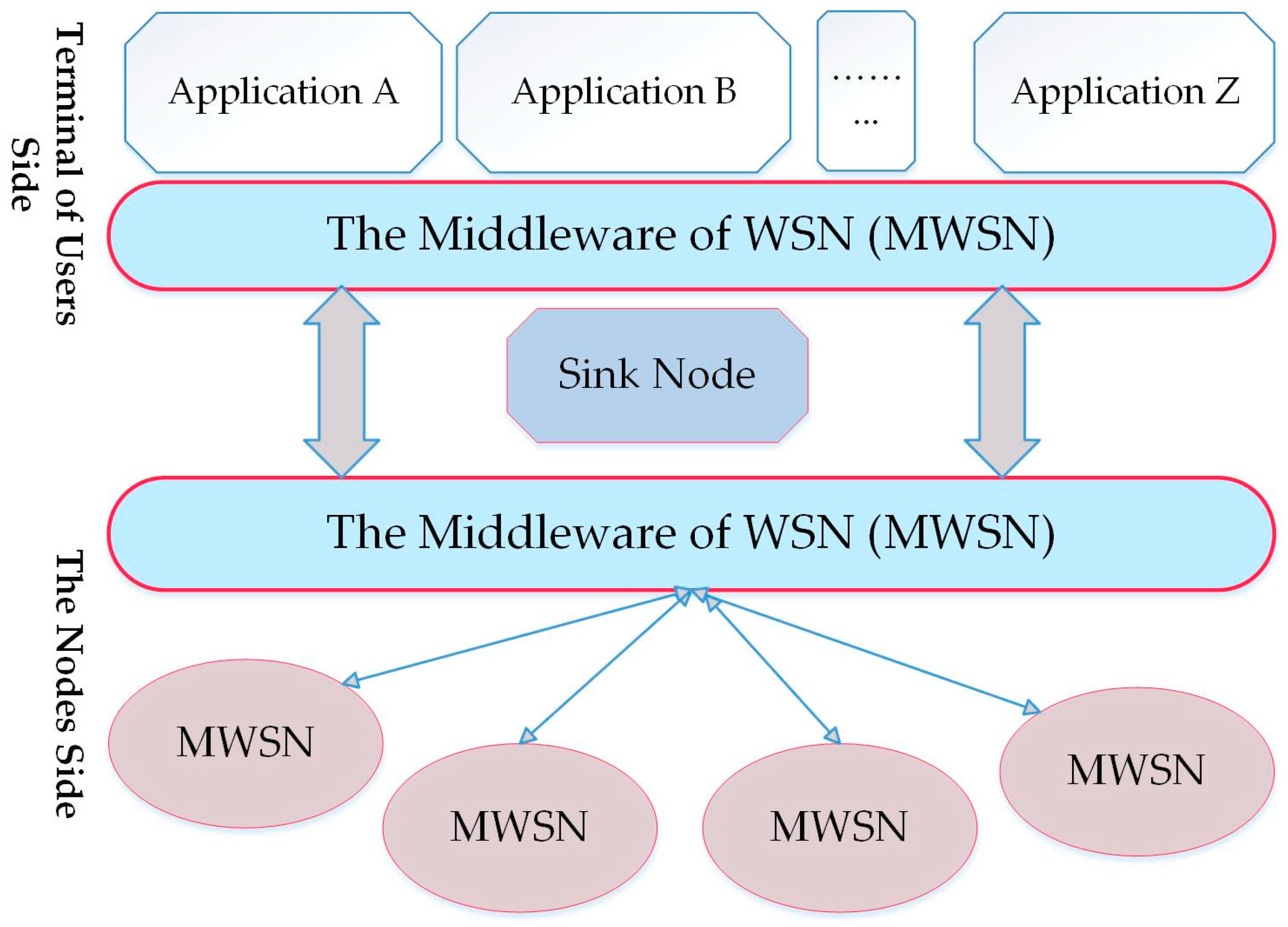
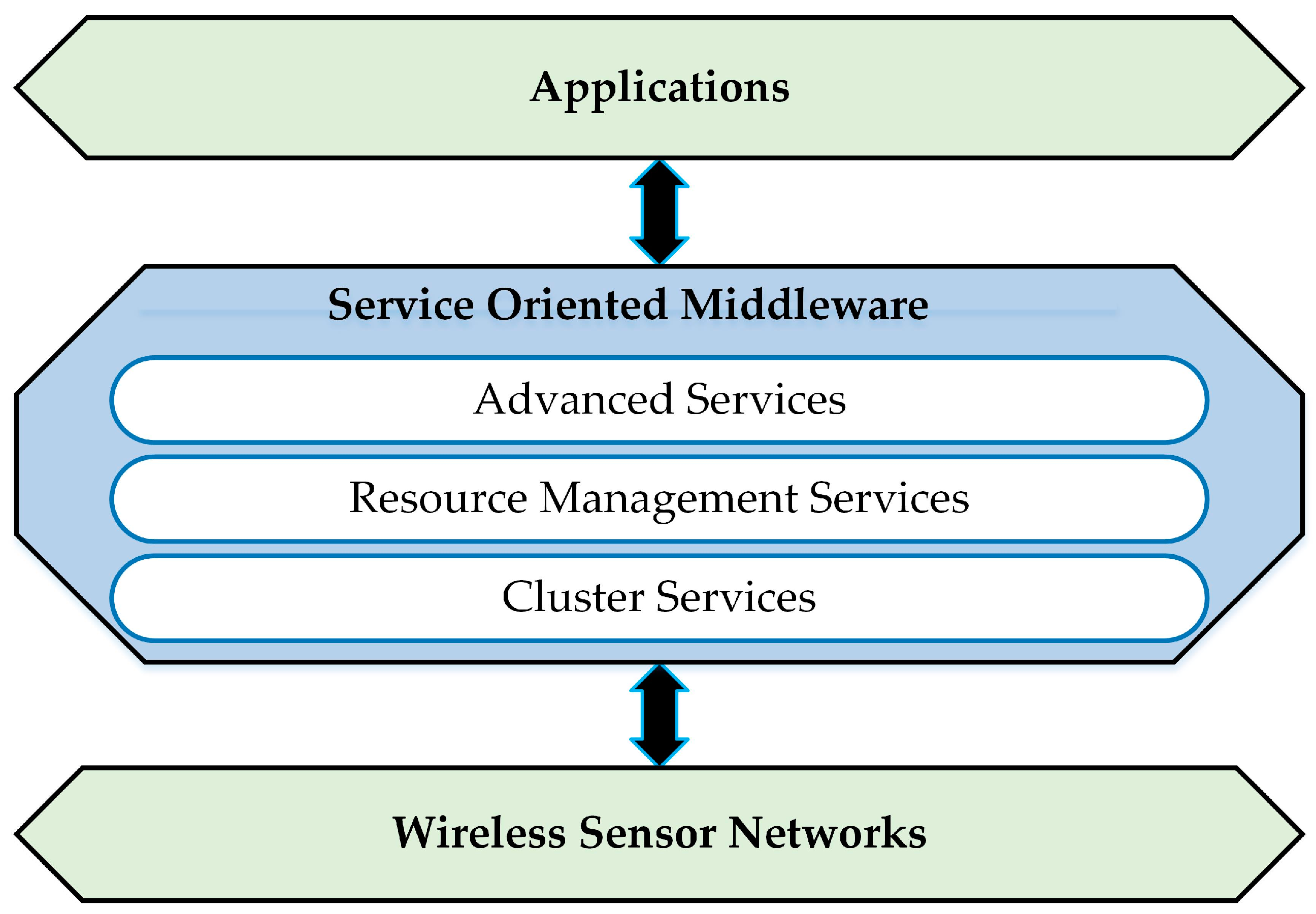
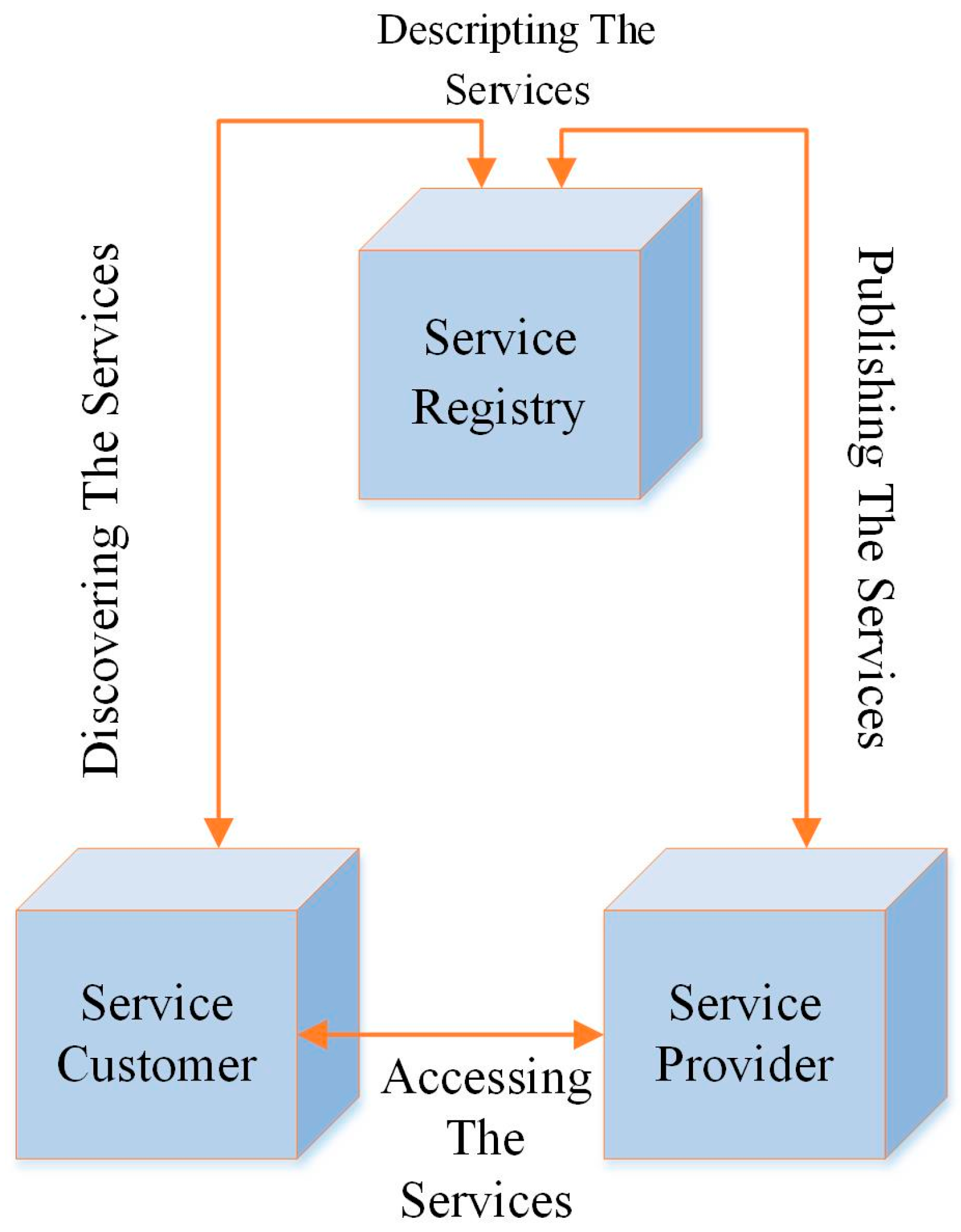
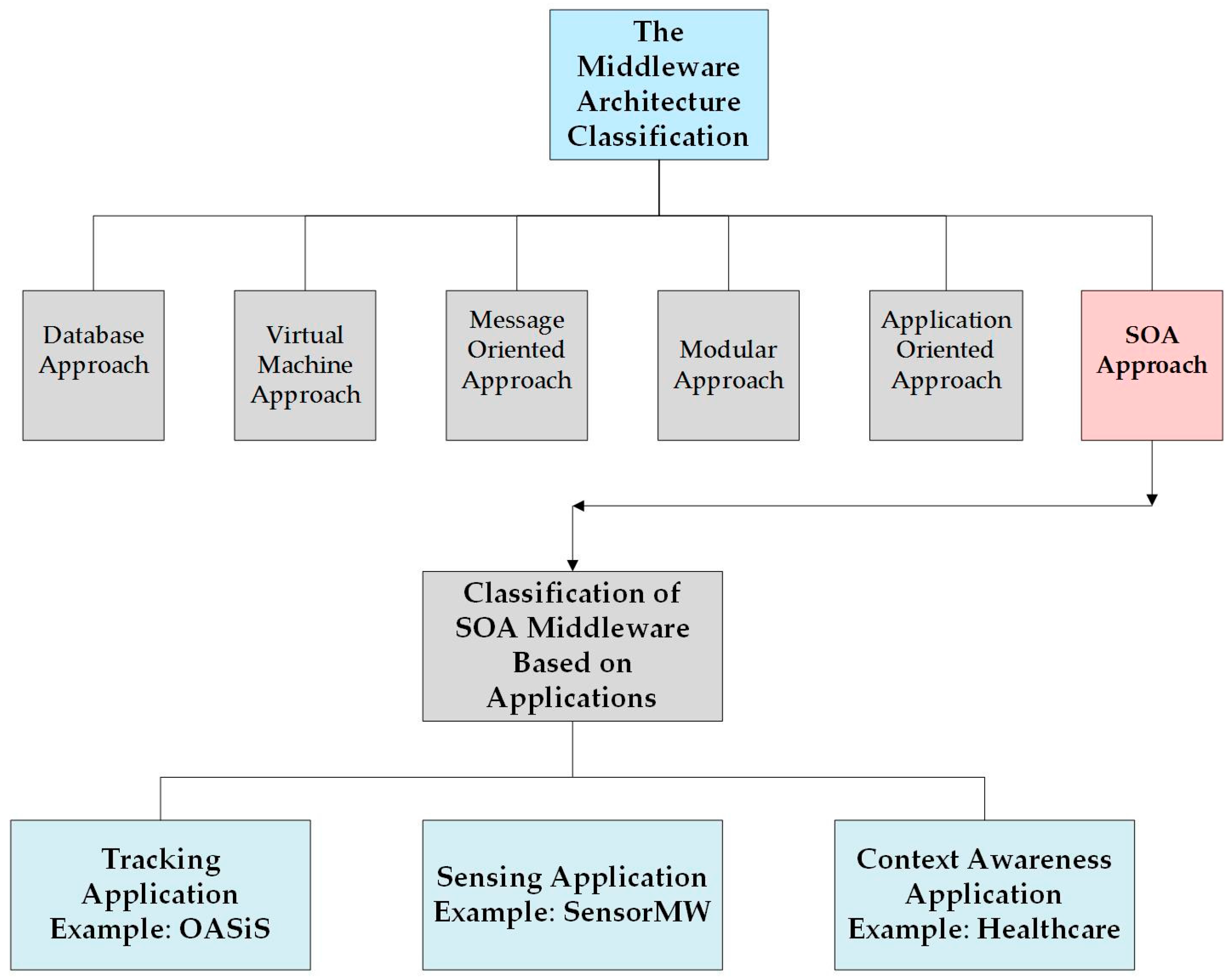
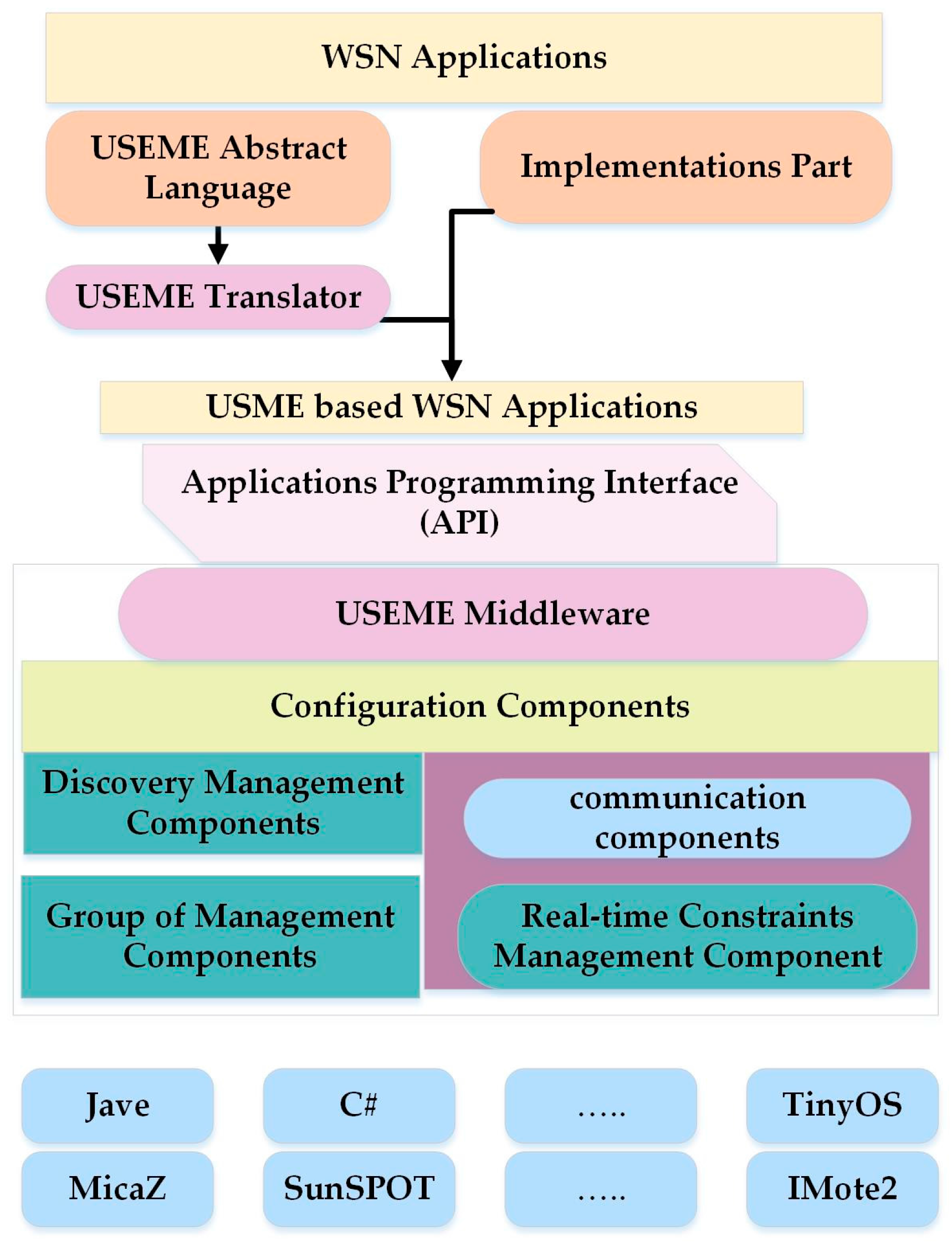
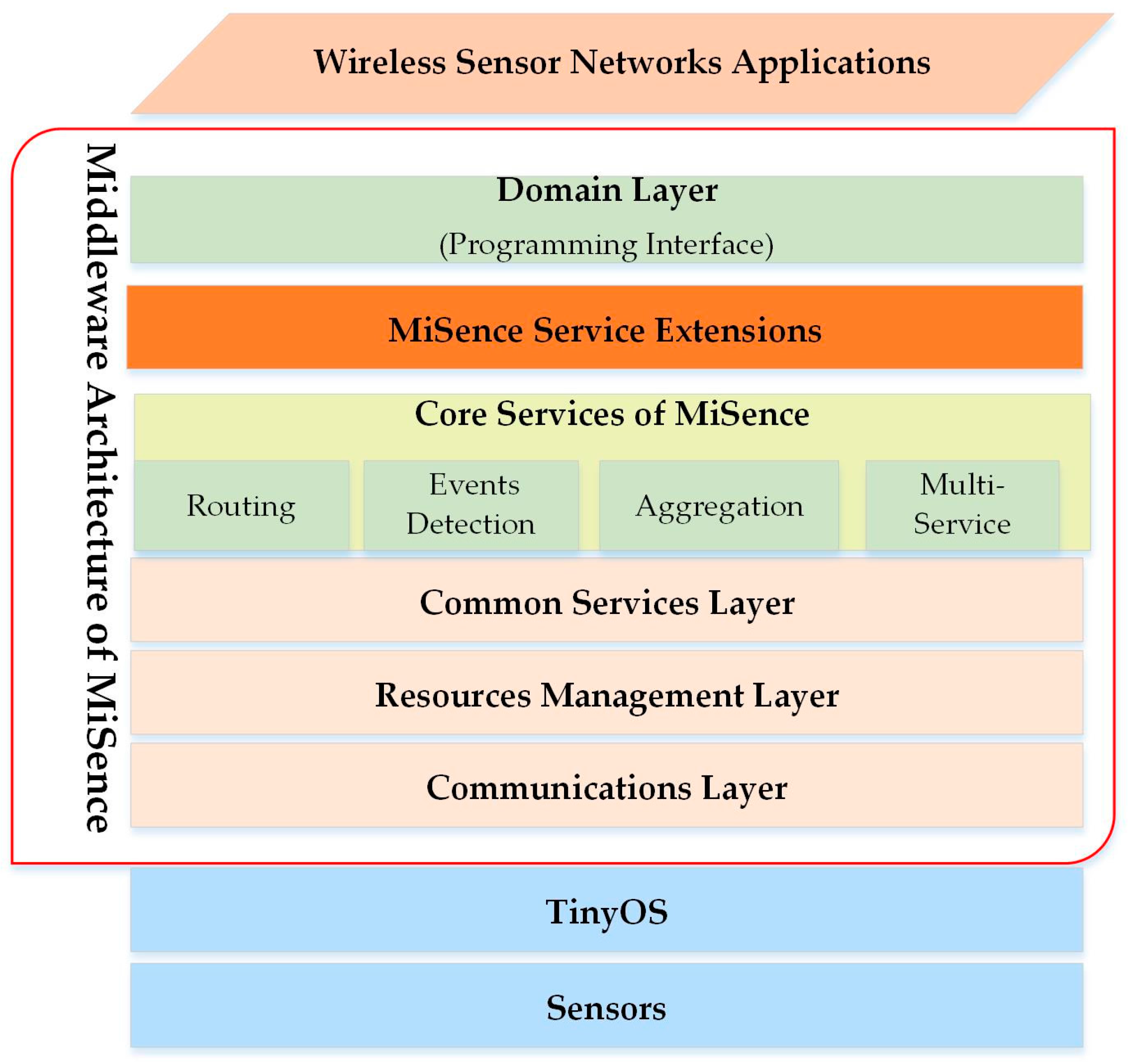



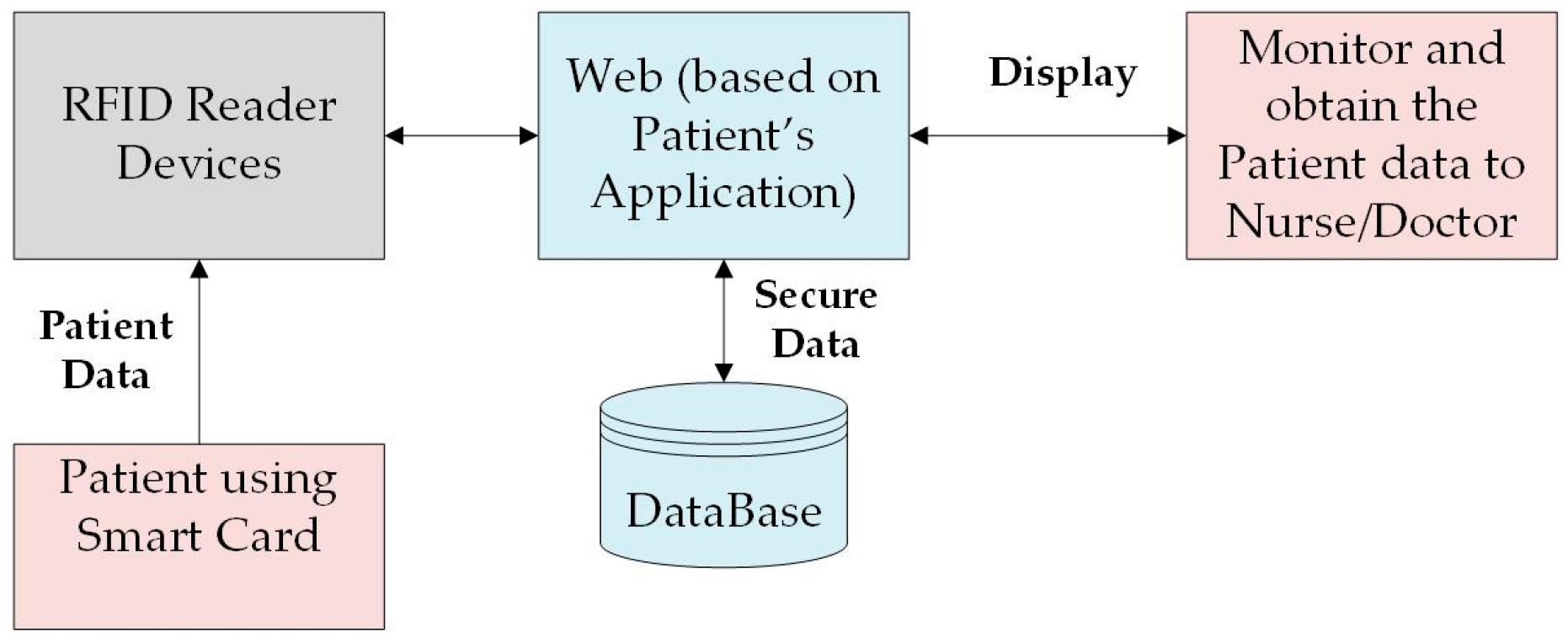
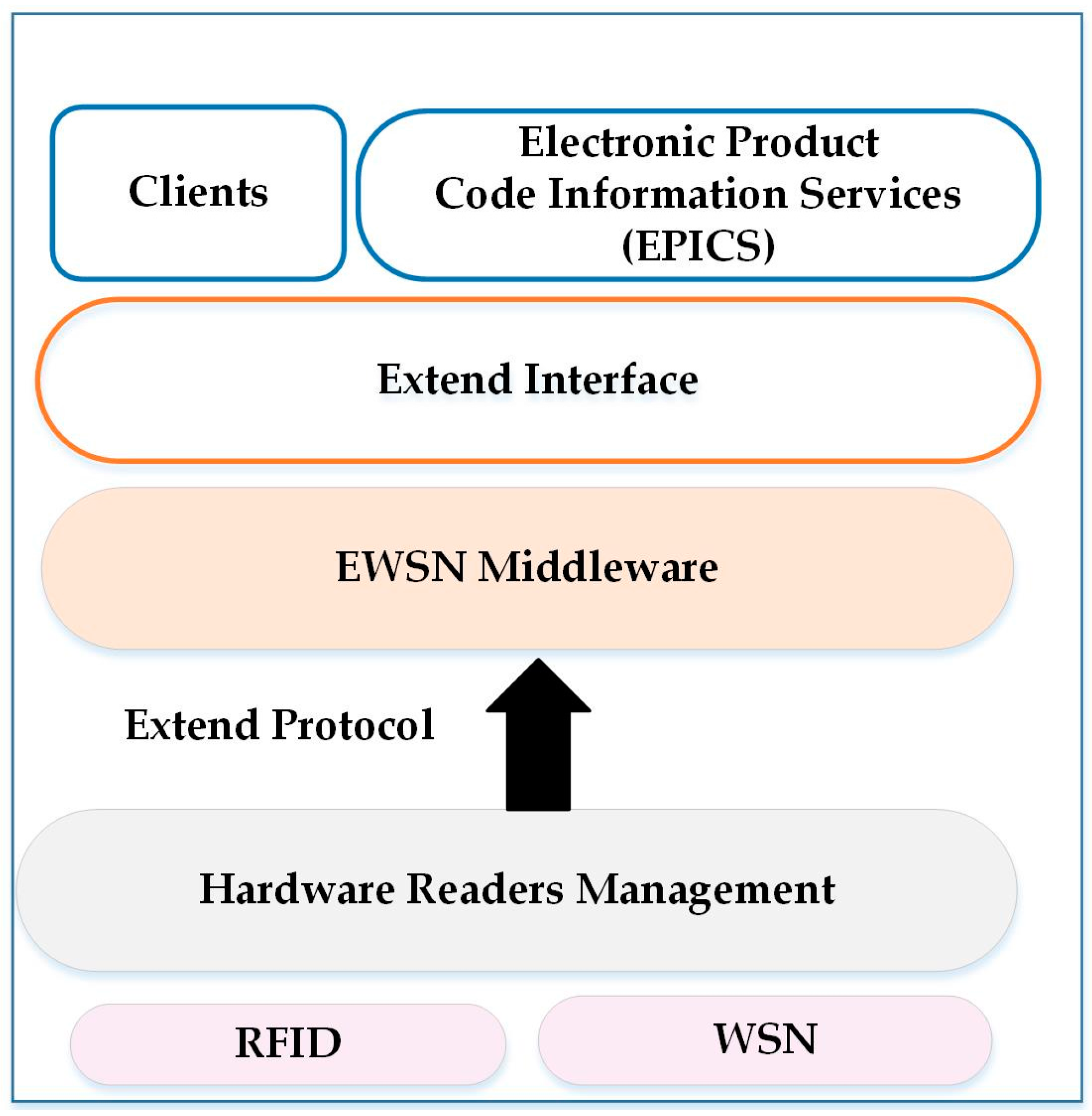

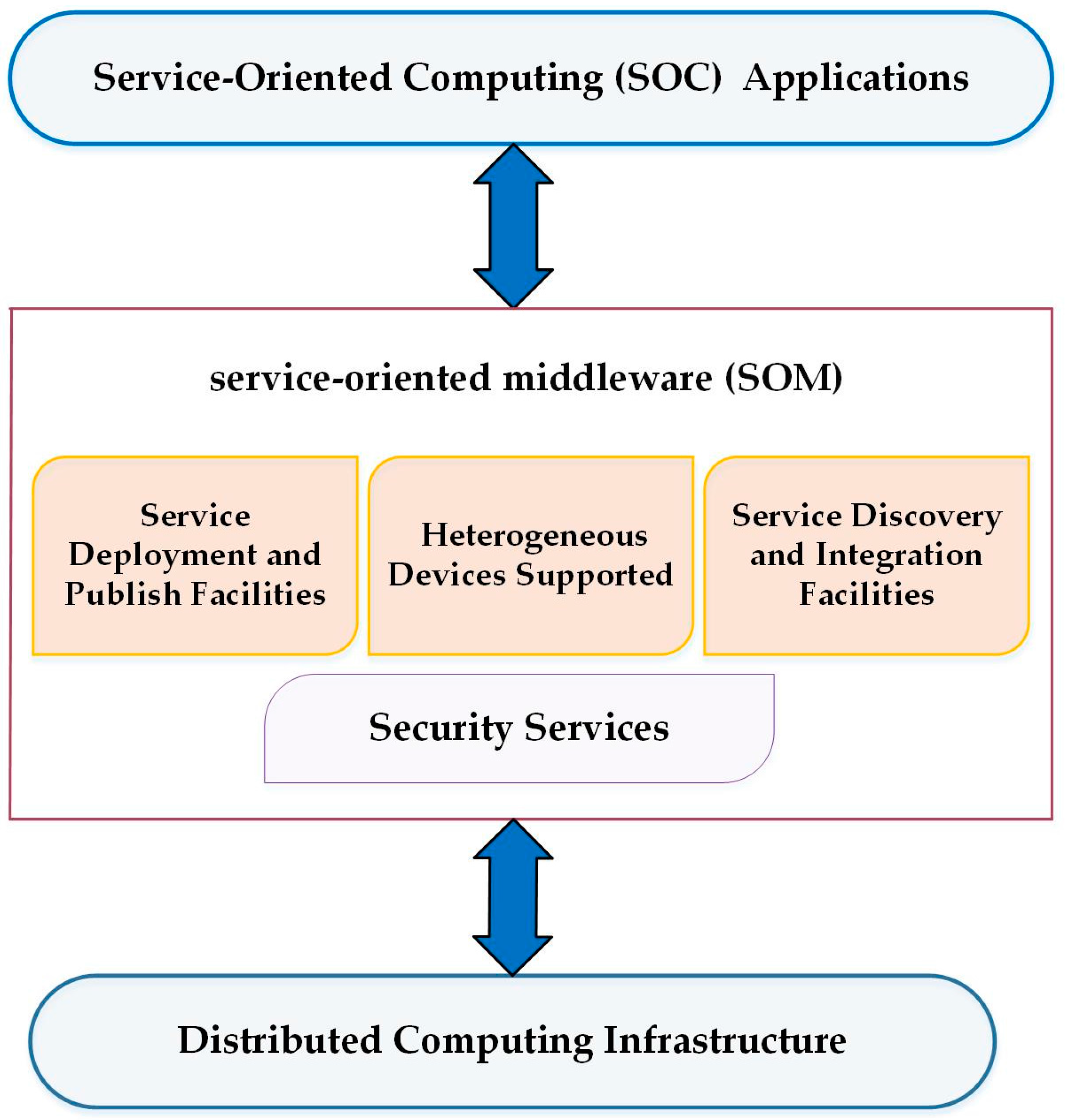
| Middleware Approaches | Scalability | Heterogeneity | Ese to Used | Power Awareness | Application Type | Security | QoS |
|---|---|---|---|---|---|---|---|
| Database Approach | Not Supported | none | Yes | None | Event driven applications | None | None |
| Virtual Machine Approach | Supported | Not fully Supported | Little | Supported | Dynamic Applications | Yes | None |
| Message Oriented Approach | Supported | Not fully Supported | Yes | Supported | Event driven applications | Little | None |
| Modular Approach | Supported | None | Yes | Supported | Dynamic Applications | Yes | None |
| Application Driven Approach | Supported | None | Yes | None/Partial | Real-time applications | None | Yes |
| SOM Architecture | Platform Type | Operating System/Platform Independence | Software Applications and Communication Model | Data/Service Aggregation | Heterogeneity |
| USEME [45,46] | WSANs | Independent with in-network middleware | Abstract programming language (APL) | Not Supported | Not Supported |
| OASIS [34,35] | WSNs | Independent with in-network middleware (middleware is implemented on Mica2 mote hardware Platform) | Application development based on the separation of concerns (SoC) | Supported | Supported |
| MiSense [42] | WSNs | Built on top of TinyOS operating system | Programming Interface and Services Extensions | Supported | Not Supported |
| SOMDM [47] | WSNs | Independent with in-network middleware | Implemented based on Ambient Programming Model with the ported code in GALS by using Tiny GALS given by TinyOS | Not Supported | Not Supported |
| TinySOA [53] | WSNs | Independent with in-network middleware | Not Supported | Not Supported | Not Supported |
| SensorsMW [49] | WSNs | Independent with in-network middleware | Not Supported | Supported | Not Available |
| SAWM [52] | WSNs | Middleware for WMSNs | Infra-red cameras are applied to decrease the power consumption | Not Supported | Supported |
| Mob-WS [48] | WSN | Independent with in-network middleware | XML for the messages instead of using any transport protocols | Not Supported | Not Available |
| SOMM [51] | Distributed Enterprise systems | Independence with in-network middleware | Programming tasks based on byte-code | Not Supported | Supported |
| ESOA [54] | WSN | Built on top of LiteOS operating system | Not Supported | Supported | Supported |
| SOM Architecture | Multi-Service Composition | Services | |||
| USEME [45,46] | Supported |
| |||
| OASIS [34,35] | Supported | ||||
| MiSense [42] | Not Supported |
| |||
| SOMDM [47] | Not Supported | Not Available | |||
| TinySOA [53] | Not Supported |
| |||
| SensorsMW [49] | Not Supported |
| |||
| SAWM [52] | Not Supported | Not Available | |||
| Mob-WS [48] | Not Supported | Not Available | |||
| SOMM [51] | Not Supported |
| |||
| ESOA [54] | Supported |
| |||
| SOM Architecture | The Features and Advantages | Disadvantages |
|---|---|---|
| USEME [45,46] |
|
|
| OASIS [34,35] |
|
|
| MiSense [42] |
|
|
| SOMDM [47] |
|
|
| TinySOA [53] |
|
|
| SensorsMW [49] |
|
|
| Mob-WS [48] | Increases the scalability |
|
| SOMM [51] |
|
|
| SAWM [52] |
|
|
| ESOA [54] |
|
|
| SOM Architecture | The Requirements | The Purpose of Middleware Architecture |
|---|---|---|
| USEME [45,46] |
| Middleware provide general-services such as configuration, invocation, and communication managements |
| OASIS [34,35] |
|
|
| MiSense [42] |
|
|
| SOMDM [47] |
|
|
| TinySOA [53] |
|
|
| SensorsMW [49] |
|
|
| Mob-WS [48] |
| Provides the best management and representation of wireless networks |
| SOMM [51] |
|
|
| SAWM [52] |
|
|
| ESOA [54] |
| Coordination, Monitoring, Conformance, QoS and Service Discovery |
| SOA Approaches | Operating System/Platform Independence | Type of Software Applications | Multi-Service Composition |
|---|---|---|---|
| SODA for Smart Environment [71] | Mulle Sensor Platform (resource constrained sensor platform) | Built upon the gSOAP toolkit with TCP/IP stack-lwIP | Not Supported |
| SOA Model for Sensor Networks [72] | Not Supported | Built on different applications such as Agent Register, Resource Manager, and Multi-gateway | Not Supported |
| WSNs Cloud User Interaction [73,74,75] |
| Done by XML | Not Supported |
| FSONA [79] | Not Supported | Developed with Java Platform | Supported |
| Healthcare Approaches | Built on ambient intelligence (AI) [64] Java (JDK 1.6, Apache tomcat server 6.0.) [65] and Java EE5 platform of NetBeans [66] | Supported | |
| OGC-SWE standards (Web Service) | WASP
has two sides
| Built smart home system uses the SWE standard | None |
| Configuration Service [76] | Middleware Framework | Evaluation in CORE and EMANE | Not Available |
| SOA Approaches | The Features and Advantages | Disadvantages |
|---|---|---|
| SODA for smart environment [71] |
|
|
| SOA Model for Sensor Networks [72] |
| Does not test in real time |
| WSNs Cloud User Interaction [73,74,75] |
| Overhead |
| FSONA [79] | Process heterogeneous wireless mobile networking. Costs are reduced | Overhead |
| SYLPH [64] WBSNs [65] SunShine [66] | provides a flexible distribution of resources SYLPH and capable during performance time to add new component [64] Decreases memory space, interoperability of service, maintenance cost, fast response time, high privacy, and throughput. This technique was improved the QoS to make decision and time warning generation the authentication mechanism and lightweight and efficient biosensor [65] Collecting and managing then analyzing data [66] Cost reduces [66] It modify the requirement of monitoring [66] | SYPLH is that it has not been tested in real time [64] Framework has overhead due to the use of XML and SOAP in the system [65] Not support Security [66] |
| OGC-SWE standards (Web Service) | WASP It process the raw data from WSNs [68,70] SeNoMa-cloud [70,71]
|
It provides mechanisms to detect and determine failure [70,71]. Overhead by using XML based web service [72]. |
| SOA Approach | The Requirements |
|---|---|
| SODA for Smart Environment [71] |
|
| SOA Model for Sensor Networks [72] |
|
| WSNs Cloud User Interaction |
|
| FSONA [79] |
|
| SYLPH [64] |
|
| OGC-SWE standards (Web Service) [68,70] |
|
| ANDSF |
|
| Healthcare Approaches |
|
| Configuration Service [76] |
|
| SOA Approaches | Service Composition Programming | Active Service Composition | Services Integrated with IoT | Advantages | Disadvantages |
|---|---|---|---|---|---|
| SCPQ [92,93] | Not Supported | Service based on Greedy algorithm | Not Supported |
| None |
| Intelligent SWSN Middleware [94] | Proprietary semantic annotations for WSDL and XML | Semantic Web Services | Interoperability using WS-specifications | Collects information through the nodes can be reusable resources in the real world |
|
© 2017 by the authors. Licensee MDPI, Basel, Switzerland. This article is an open access article distributed under the terms and conditions of the Creative Commons Attribution (CC BY) license ( http://creativecommons.org/licenses/by/4.0/).
Share and Cite
Alshinina, R.; Elleithy, K. Performance and Challenges of Service-Oriented Architecture for Wireless Sensor Networks. Sensors 2017, 17, 536. https://doi.org/10.3390/s17030536
Alshinina R, Elleithy K. Performance and Challenges of Service-Oriented Architecture for Wireless Sensor Networks. Sensors. 2017; 17(3):536. https://doi.org/10.3390/s17030536
Chicago/Turabian StyleAlshinina, Remah, and Khaled Elleithy. 2017. "Performance and Challenges of Service-Oriented Architecture for Wireless Sensor Networks" Sensors 17, no. 3: 536. https://doi.org/10.3390/s17030536
APA StyleAlshinina, R., & Elleithy, K. (2017). Performance and Challenges of Service-Oriented Architecture for Wireless Sensor Networks. Sensors, 17(3), 536. https://doi.org/10.3390/s17030536






